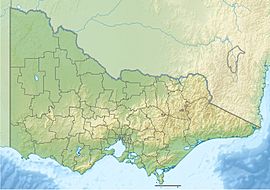Lake Eildon National Park facts for kids
Quick facts for kids Lake Eildon National ParkVictoria |
|
|---|---|
|
IUCN Category II (National Park)
|
|

Lake Eildon, the central feature of the national park
|
|
| Nearest town or city | Eildon |
| Established | 4 June 1997 |
| Area | 277.5 km2 (107.1 sq mi) |
| Managing authorities | Parks Victoria |
| Website | Lake Eildon National Park |
| See also | Protected areas of Victoria |
The Lake Eildon National Park is a fantastic national park in the Central Highlands area of Victoria, Australia. This huge park covers about 27,750 hectares (that's over 68,000 acres!). It sits in the northern foothills of the Central Highlands. The park is about 111 kilometers northeast of Melbourne and is right next to the shores of Lake Eildon. It's a perfect place for outdoor adventures!
Contents
Park History and Heritage
Ancient Land and Gold Rush Days
Long ago, the Goulburn River Valley was home to hundreds of Aboriginal Australian people. They were part of the Taungurong group. Many of their important cultural sites were covered when Lake Eildon was built.
The park also holds secrets from Victoria's exciting gold rush in the 1860s. You can still find old mine shafts from that time. There are also signs of early farming and pastoral use in the park.
How the Park Was Formed
In the 1950s, the Victorian Government bought farms along the Goulburn and Delatite rivers. This was to build Lake Eildon. The lake was created to provide water for farms in the Goulburn Valley.
An area of 2,670 hectares that didn't get flooded became Fraser National Park in 1957. Later, in 1980, about 24,000 hectares of state forest next to the lake became Eildon State Park. This was to protect the water that flowed into Lake Eildon. Finally, in 1997, these two parks joined together. They formed the Lake Eildon National Park we know today.
Geology of the Park
Mountains and Ancient Volcanoes
Lake Eildon National Park is very mountainous. Some peaks reach up to 900 meters high. The park also sits on the edge of something amazing: the Cerberean Caldera.
A caldera is a huge, bowl-shaped hollow. It forms when a volcano erupts and then collapses. The Cerberean Caldera was a giant circular volcano. It was about 27 kilometers across! This volcano was active around 380 million years ago. You can still see parts of this ancient volcano today. Look for granite rocks sticking out of the ground. Scientists think this volcano had a "super eruption" about 374 million years ago. This huge event might have even contributed to a major extinction event long ago.
Plants and Animals
Forests and Eucalypt Trees
The park's plant life is mostly dry, open eucalypt forest. You'll also find areas of forest near rivers and streams. Higher up, there are montane forests. The main types of eucalypt trees you'll see are stringybarks, peppermints, Red Box, and Candlebark. In some spots, there are also Mountain Ash and Blue Gum trees.
Wildlife in the Park
Lake Eildon National Park is home to many different animals. Scientists have recorded 34 types of mammals living here. There are also 89 kinds of birds, 17 reptiles, and 10 amphibians. You might even spot three different types of freshwater fish.
Some special animals that live in the park are the Brush-tailed Phascogale. This is a small, furry marsupial. Another special animal is the Spotted Tree-Frog. These animals are considered threatened, which means they need our protection. You'll also see lots of Eastern Grey Kangaroos. They are very common, especially in the park's camping areas.
Things to Do in the Park
Water Fun and More
Most people who visit Lake Eildon National Park love water activities. The park is a great base for fun on Lake Eildon. You can go power boating or water skiing. It's a perfect spot for a day out on the water!
The park also offers other activities. You can explore the old mine shafts and historical sites. Hiking trails let you discover the beautiful forests and mountain views. It's a great place to connect with nature and learn about history.
Images for kids





